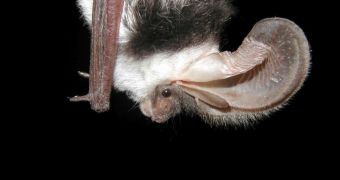In spite of being constantly overlooked by any type of conservation or domestication programs, bats are critically important to agriculture, performing a service that would otherwise cost the US federal government an estimated $3 billion per year.
These creatures provide a tremendously-efficient pest-control service, eating up insects that would otherwise decimate crops. The economic importance insect-eating bats have is constantly overlooked in the US, investigators explain in the latest issue of the Science magazine Policy Forum.
Scientists with the US Geological Survey (USGS) were also involved in the research, which analyzed the status of bats. The team looked at how people and authorities thought of the flying creatures, in regards to the services these animals brought for everyone.
According to the analysis, it could be that bats may go on to save up to $53 billion per years in agriculture costs. The sum varies according to how many pests start affecting crops each year.
“People often ask why we should care about bats. This analysis suggests that bats are saving us big bucks by gobbling up insects that eat or damage our crops,” says USGS research scientist Paul Cryan.
“It is obviously beneficial that insectivorous bats are patrolling the skies at night above our fields and forests – these bats deserve help,” adds the expert, also an author of the new study.
Researchers from the University of Pretoria, in South Africa, the University of Tennessee and Boston University were also involved in the new study. The team also identifies the threats bat populations are subjected to at this point.
Emerging disease are wiping out entire bat colonies in one go, and the condition appears to be spreading throughout the United States. If it continues, the economic effects of losing these predators could be felt within the next 4 to 5 years.
“Bats eat tremendous quantities of flying pest insects, so the loss of bats is likely to have long-term effects on agricultural and ecological systems,” explains researcher Justin Boyles.
“Consequently, not only is the conservation of bats important for the well-being of ecosystems, but it is also in the best interest of national and international economies,” he adds. The expert, based at UP, was the lead author of the study.
The investigators say that the million bats which were lost in the northeastern parts of the US alone led to the survival of between 660 and 1320 metric tons of insects. These creatures then went on to consume or otherwise affect crops.
“Additionally, because the agricultural value of bats in the Northeast is small compared with other parts of the country, such losses could be even more substantial in the extensive agricultural regions in the Midwest and the Great Plains where wind-energy development is booming and the fungus responsible for white-nose syndrome was recently detected,” adds Tom Kunz
The BU professor of ecology, a coauthor of the study, says that the white-nose syndrome is the primary bat killer at work today. Details of the new investigation appear in the April 1 issue of the journal Science.

 14 DAY TRIAL //
14 DAY TRIAL //